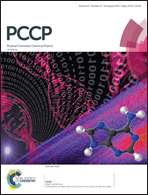Kinetics of in situ desorption of dye molecules on sensitized TiO2 nanoparticles in a high concentration solution: ion parasitic adsorption process and mass reference
Abstract
The reverse process of dye molecule adsorption on the surface of nanoparticles, that is, the desorption process, has long been neglected in the field of dye-sensitized solar cells (DSCs). It is crucial to develop an in situ technology that controls the rate of dye desorption. Meanwhile, controlling the coverage of dye-sensitized films is still a major challenge. The work presented in this paper applies a simple and effective method to study the in situ mass change responses on dye-sensitized TiO2 films over different potential ranges. The result shows that dye molecule desorption is accompanied by the adsorption of ions in solution. Due to this parasitic adsorption process, the frequency responses in the electrochemical quartz crystal microbalance (EQCM) test cannot be completely attributable to dye molecule desorption. We established a new model to eliminate the impact of this parasitic adsorption process. The kinetics of in situ desorption of dye molecules on sensitized TiO2 nanoparticles in a high-concentration solution was studied. We found that the in situ desorption of dye could be described by pseudo-first-order kinetics. The results suggest that the dye in situ desorption rate is dependent on the bias voltage, and the coverage of dye on the surface of TiO2 films can be further controlled. In-depth research of the dye desorption process is theoretically significant to study DSC stability, new dye synthesis and complex interface structures.



 Please wait while we load your content...
Please wait while we load your content...